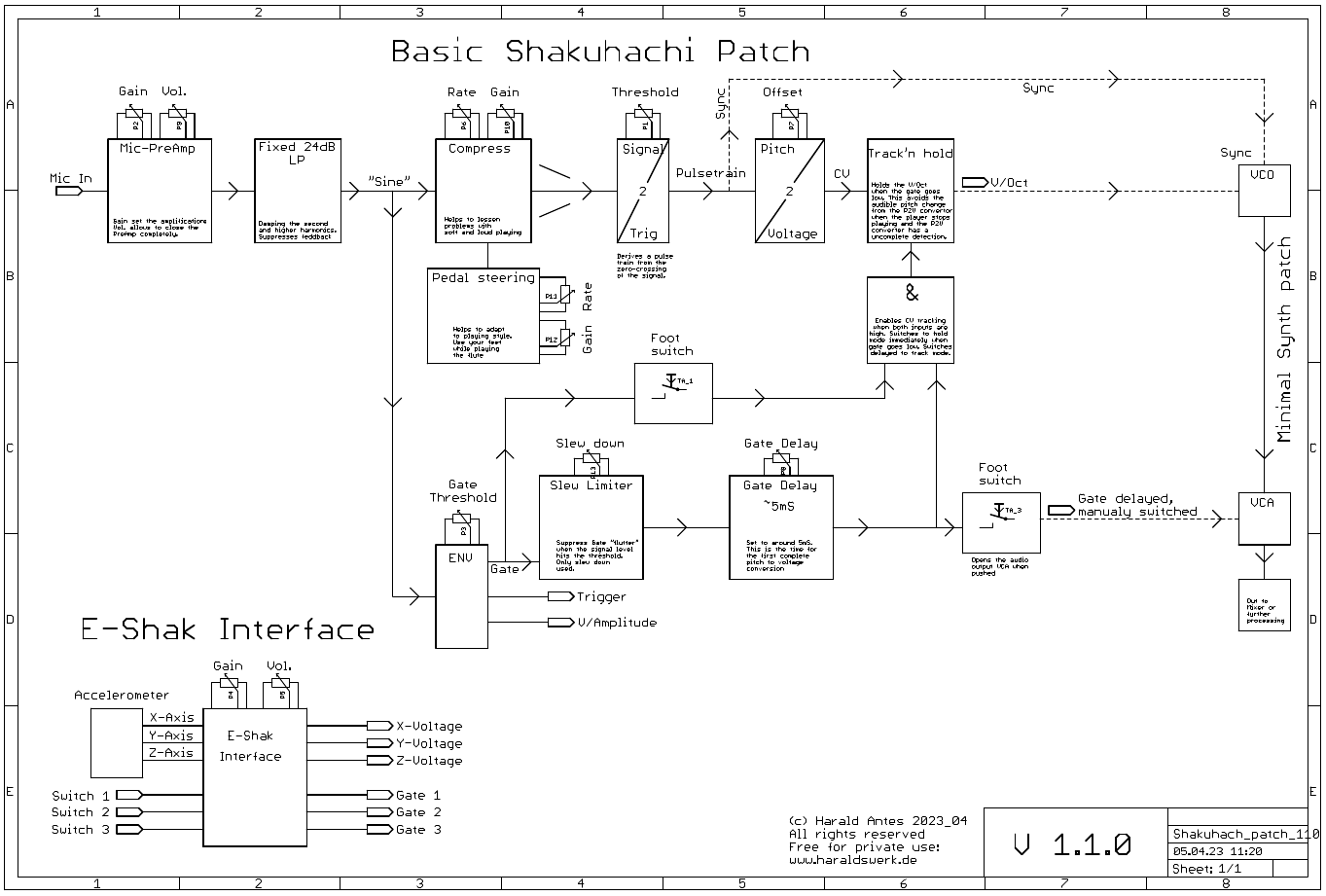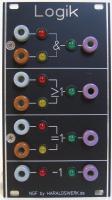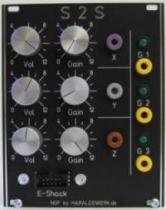Motivation
I have build my first synthesizer in the late 70’s. And I am playing Shakuhachi for several years now. Time to bring both worlds together. Here we go.
The aim of this project is to provide Shakuhachi players with the means to control an (analogue) synthesizer simultaneously while playing the Shakuhachi, without affecting the playability of the flute.
So far the core consists of three main modules: the pitch-to-voltage converter, the envelope follower and the “E-Shak”. With some supporting modules around them. The pitch-to-voltage converter derives a voltage from the pitch played on the Shakuhachi. This is used primarily to control the pitch of the VCO (which is the initial generator of waves in the synthesizer). The envelope follower provides a voltage which follows the volume of the Shakuhachi signal, together with gate and trigger signals. These are used mainly in conjunction with the synthesizer’s VCA (which is responsible for the dynamics of the synthesizer’s signal). The “E-Shak” is an exoskeleton attached to the Shakuhachi with crepe tape. It is equipped with an accelerometer with three axes and with three switches. This module provides three control voltages according to the movement of the Shakuhachi, and three additional on/off switches. The usage is only limited by the player’s imagination.
The main problem is to detect the frequency in the lower octave (otsu) when the player adds overtones (second harmonics). If the volume off the second harmonic rises about a certain point the pitch to voltage detection is screwed up. To avoid this the Shakuhachi player has to take care of his playing stile. It is hard to come by this problem technically because the second harmonic in the lower register (otsu) equals the pitch in the higher register (kan). I have taken some countermeasures against this, but in the analogue world it can not completely resolved. In the moment I have a good working all analog system (except the pitch to voltage converter which is digital) which tracks the pitch very well when the player gets used to it and handles the overtones with some care. I have gone through a lot of configurations and optimizations of the modules. I can think of a few more improvements in the analog world, but it is coming to an end. Maybe the digital world is the next logical step. I can think of programming a DSP or such. I am a bit hesitant though. I know I can do it, but I'd love to stay in the analog world.

Shakuhachi 2 Synth project: Basic patch - 2023/04
In the basic patch you can see the basic structure and patch of the project. The microphone signal goes to the microphone pre-amplifier. The output is then low-pass filtered to dampen the second harmonic. The low-pass filter suppresses feedback loops as well. The signal is then compressed to take care of the wide dynamic range of the Shakuhachi. The compressor ratio and gain is steerable with foot pedals (optional) to be adaptable to various playing styles of the player without removing the hand from the flute. The signal to trigger module generate a pulse train which is feed in the pitch to voltage converter. The output of the pitch to voltage converter is a V/Oct voltage according to the pitch of the Shakuhachi. The V/Oct voltage can be offset to fit the needs of the used VCO. The Track and Hold module holds the V/Oct voltage when the output from the AND gate is low and tracks when the output is high. The AND gate goes low immediately when the player stops playing. This avoids the audible pitch change from the P2V converter when the player stops playing and therefore the P2V converter has a incomplete detection. The AND gate goes high after around 5mS when the player starts playing. This is needed to have at least a completed pitch to voltage conversion. The delay of 5mS is done with the Gate Delay module. The Slew Limiter before the Gate Delay suppresses Gate "flutter" when the signal level hits the gate threshold. Only slew down is used here. Two foot switches are used. The one before the VCA blocks the Gate signal to the VCA when open, the other one disable track mode when open.
The signal for the envelope follower is taken from behind the low-pass filter. The envelope follower generates the gate (+5V), the trigger (+5V/20ms) and a voltage following the amplitude of the input signal.
Currently the patch consists of a lot modules. Some more general purpose some specific project related. It is still an ongoing project. With such a lot of modules there are many parameters to tweak and patchpoints to move around. The main goal is still to build a standalone device for easy use. Which means stripping down the more general modules to the used functions, eliminating every unused function. The software for the pitch to voltage converter needs some tweaking and testing different approaches as well.
The “E-Shak” is an exoskeleton equipped with a three axis accelerometer and three touch sensitive switches. With the interface you can adjust the gain and the inclination of the accelerometer signal. It provides three gate signal (+5V) as well.
Latest update 2021/11
Picture from 2021 November |














